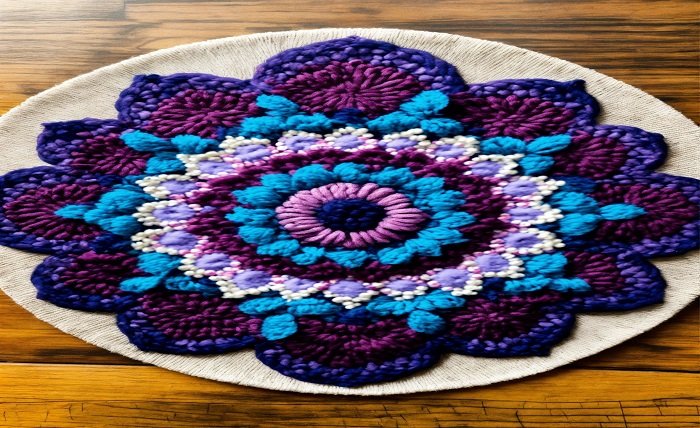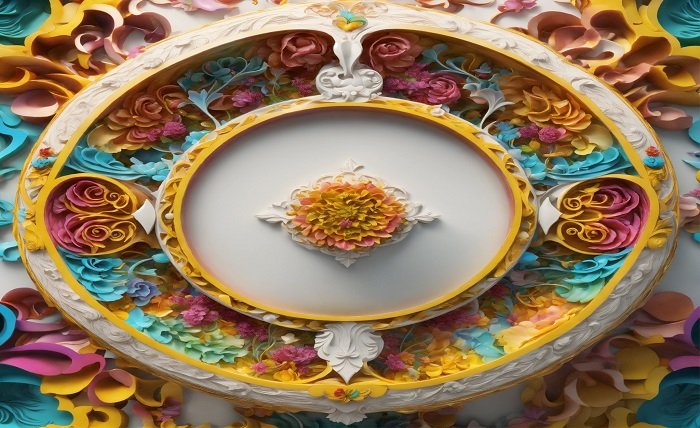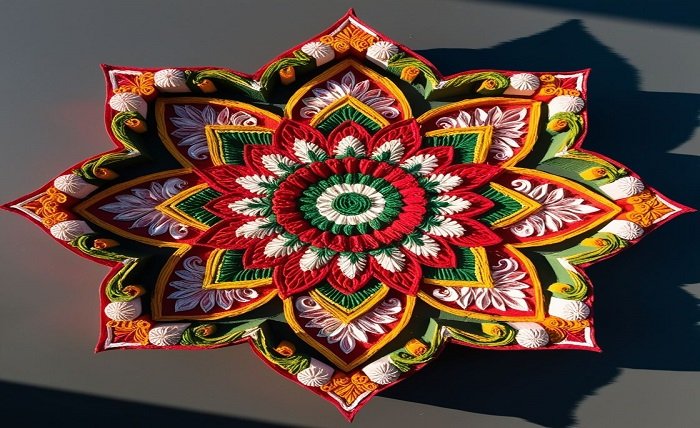A classic Indian art form, rangoli has won over many people’s hearts with its vivid colors and detailed designs. Usually made for festivals, festivities, and other special occasions, it is a representation of welcome, wealth, and good fortune. The advent of 3D rangoli has given this lovely art form a new depth, even if classic rangoli designs have been appreciated for generations. We will go into the intriguing realm of 3D rangoli in this blog article, covering its importance, methods, and much more.
3D Rangoli: What is it?
A contemporary take on the ancient art genre, 3D rangoli involves creating designs that appear three-dimensional by utilizing a variety of techniques. In contrast to the flat patterns of traditional rangoli, 3D rangoli makes use of perspective, depth, and shadows to produce illusions that appear to rise out of the surface. By experimenting with different colors and shapes, this creative method enables artists to create works that are more dynamic and striking.
The key to creating a 3D rangoli is combining technique and creativity. To get the desired appearance, artists frequently utilize a range of materials, such as colored powders, flowers, and even clay. The possibilities for producing breathtaking 3D rangoli designs have greatly increased because to technological improvements and the availability of a wider variety of materials.
The Importance of Rangoli in Indian Traditions
In Indian tradition, rangolis have a special position as a tool for celebration, self-expression, and spiritual bonding. Rangoli is traditionally made at a home’s door to greet guests and gods, particularly on holidays like Diwali, Pongal, and Onam. It’s common knowledge that the elaborate designs bestow wealth and good fortune upon households.
Cultural Background
Festivals & Celebrations: Rangoli is an essential component of the festivities during significant festivals. For example, on Diwali, families make intricate rangoli decorations with vivid colors and patterns, frequently using peacocks and lotus flowers as emblems.
Worship & Spirituality: Because rangoli is said to bring divine energy into houses, it is also a form of worship. The religious significance of the art form is increased by the inclusion of sacred symbols like swastikas and gods’ footprints in many of the designs.
Community & Togetherness: Making rangoli is frequently a social activity that unites neighbors and families. It promotes a feeling of togetherness and delight that is shared, particularly during festivals.
Rangoli’s transformation into a three-dimensional shape preserves its fundamental principles while reflecting the shifting dynamics of culture. Because of the unique ways in which artists can express their creativity and connect with tradition, the art form will continue to hold relevance in today’s culture.
Methods for Making Three-D Rangoli

There are multiple strategies involved in creating 3D rangoli, which improve the designs’ visual impact. The following are some common techniques employed by artists to create the illusion of three dimensions:
Stacking
One of the most popular methods for creating 3D rangoli is layering. To add depth to their designs, artists apply several layers of colored powder or other materials. The design can give the impression that it is rising from the surface by adjusting the thickness of each layer, producing an amazing optical illusion.
Hueing and Combining
In order to give 3D rangoli dimension, shading is essential. To achieve a gradient effect, artists utilize lighter hues in the center and darker shades on the edges of their paintings. The design appears more lifelike and three-dimensional as a result of this mixing.
Utilizing Shadows
Rangoli’s 3D effect can be greatly improved by adding shadows. Artists can produce shadows that provide the impression of depth and dimension by carefully laying darker powders or by utilizing materials like charcoal or black sand.
Techniques of Perspective
Some artists use perspective tricks to provide the impression of depth and distance. This entails changing the scale and proportion of various design elements to provide the impression that certain portions are closer to others or farther away.
Fifth, Including Objects
Three-dimensional items can be added by artists to their rangoli patterns for a more noticeable 3D impact. Small clay figurines, flowers, or even ornamental objects that fit well with the rangoli and improve its overall appeal could be included in this.
Components of 3D Rangoli
The components of 3D rangoli are essential to producing the intended results. A wide range of alternatives are available for artists to select from, depending on their preferences, availability, and the particular design they want to create. Here are a few materials that are often used:
Powders in colors
The main ingredient used to create rangoli designs is colored powder, sometimes referred to as rangoli colors. These powders are available in a variety of colors and can be blended to produce unique tones. To add a special touch to their rangoli, some artists even utilize natural colors derived from flowers, spices, or other organic components.
Petals of Flowers
Fresh flower petals are frequently added to rangoli designs to give them a scent and a natural touch. The creation’s overall attractiveness can be enhanced by layering them or using them to highlight particular patterns.
Rice and Sand
Intricate designs can also be made with colored rice and sand. Artists can play with various textures and effects by shaping and layering these materials with ease.
Materials for Sculpting and Clay
Clay and other sculpting materials can be molded into different shapes and used in conjunction with colored powders for artists wishing to add 3D components. This gives the rangoli a tactile quality that enhances its appeal.
LED decorations and lights
To improve the visual impact of their 3D rangoli, several contemporary artists have begun to include decorative embellishments like LED lights. These embellishments have the potential to produce a compelling impact that makes the rangoli a captivating focal point, especially at night.
Trendy 3D Rangoli Designs and Themes

Designs for 3D Rangoli can be as simple as patterns or as complex as elaborate artwork. Here are a few well-liked concepts and themes that painters frequently work with:
Designs Inspired by Nature
Rangoli with a nature theme frequently depict flowers, leaves, and animals to highlight the wonders of the natural world. Artists can imitate the appearance of plants by layering petals and utilizing brown and green hues to create a three-dimensional image.
Holiday Themes
Artists sometimes use traditional symbols and motifs in their 3D rangoli designs during festivals. Indian cultural symbols like lotus flowers, peacocks, and diya (light) patterns are frequently featured.
Patterns in Geometry
The classic rangoli designs are given a contemporary touch with geometric patterns. Using 3D techniques, artists can construct complex forms that give patterns a dynamic and captivating appearance.
Themes from Mythology
Indian culture greatly values mythological tales and characters, which makes them popular rangoli subjects. Artists can use 3D technology to bring to life characters and themes from epic scenes such as the Mahabharata and Ramayana.
Paintings Abstraction
Artists can freely express their imagination with abstract designs. They are able to produce visually striking pieces that arouse curiosity and emotion by utilizing vivid hues and cutting-edge processes.
Summary
With the stunning combination of tradition and innovation that is 3D rangoli, artists may express their creativity in a dynamic and colorful way. This contemporary interpretation of the antiquated art form encourages the next generation to pursue their artistic potential while also preserving cultural importance. We see the development of this beloved custom as more people adopt 3D rangoli, guaranteeing that it will continue to be an essential aspect of Indian culture for many years to come.
Whether you are an experienced artist or a novice, playing around with 3D rangoli may be rather satisfying. You may produce breathtaking designs that enthrall and motivate others if you have a thorough understanding of the methods, supplies, and topics. So grab your paints and let your imagination go wild!
Read more about: Toonstream.org

